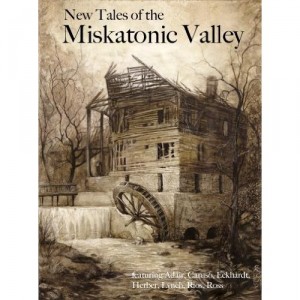Published by Miskatonic River Press, $29.95
By Keith “Doc” Herber, Tom Lynch, Oscar Rios, Kevin Ross and Christopher Smith Adair
Reviewed by Matthew Pook
New Tales of the Miskatonic Valley is special. The debut book from Miskatonic River Press, founded by the late Keith “Doc” Herber, it marked both his return to Call of Cthulhu and the first volume of all-new material for Lovecraft Country for over a decade. Its six new scenarios take you to Lovecraft Country’s dark and moldering corners, but while those sourcebooks are unnecessary to play the six, their contents can add detail.
The anthology opens with two scenarios set in Arkham. Tom Lynch’s “The Reeling Midnight” is set amidst the town’s bohemian scene. Eugene Wilcox is infatuated with the Countess Ariadne Vargas and his parents are worried that she is a gold digger. Investigating this Hungarian exile involves attending a wild party or two and plenty of detective work. The investigative process is perhaps more interesting than the final and unexpected sudden horrifying revelation.
Arkham is then beset by an unexplained outbreak of juvenile delinquency in “Wasted Youth,” by Christopher Smith Adair – shop windows smashed, cars vandalized, and an old man run down by a boy in a speeding car. The victims soon include the investigators who find that the culprits are a group of very unpleasant children, the last of which leads the party on a grueling chase across the countryside set by the Boy Scout from hell.
In “Spirit of Industry,” Oscar Rios’ first scenario in the collection, the investigators are sent to supposedly haunted Dunwich sawmill by the Arkham Advertiser’s editor, who wants proof of the existence of ghosts. It is difficult to get the investigators involved, but once they are, the scenario is a solid tale of local color and twisted machinery.
Keith Herber’s scenario is “Proof of Life,” a mystery set in quiet Foxfield where the township’s Supervisor, Henry Barnes, has received death threats. The solution lies in the town’s politics, a logging contract dispute, and finally Henry Barnes’ own odd behavior. Behind it, though, is a tragedy that exposes all involved to the utterly uncaring nature of the Mythos.
“Malice Everlasting” is the first of two scenarios set in Kingsport and is Oscar Rios’ second contribution. Its inhabitants are beset by a rash of sudden and inexplicable blindness. Is it due to illness or something else? The scenario delivers a new twist to a familiar plot idea, that of revenge from beyond the grave, and experienced investigators and players alike will surprised by the agents involved.
The second Kingsport scenario, “The Night War” by Kevin Ross, begins in media res. The investigators experience the horrors of trench warfare on the Western Front, perhaps again for veterans, probably for the first time for female investigators. Other horrors stalk No Man’s Land though, and once the investigators realize that this is a shared dream, they need to work day and night to prevent the dream from spreading. This is a grueling affair that explores the hellish effects of modern warfare.
While the book’s art is good and its layout clean and uncluttered, its maps could have been sharper. Though it’s not necessarily easy to get the investigators involved in all of these scenarios, each is a deep affair with strong ties to the community in which it is set. Many also possess horridly memorable scenes that will linger in the minds of players and investigators alike. Providing plenty of investigation, interaction, and confrontation, New Tales of the Miskatonic Valley gets eight phobias for infusing new blood into New England’s darkest corners.
This review appeared in The Eye of Light and Darkness in The Unspeakable Oath 18.
Reviewed items are rated on a scale of one to ten phobias:
1-3: Not worth purchasing.
4-6: An average item with notable flaws; at 6 it’s worth buying.
7-10: Degrees of excellence.

